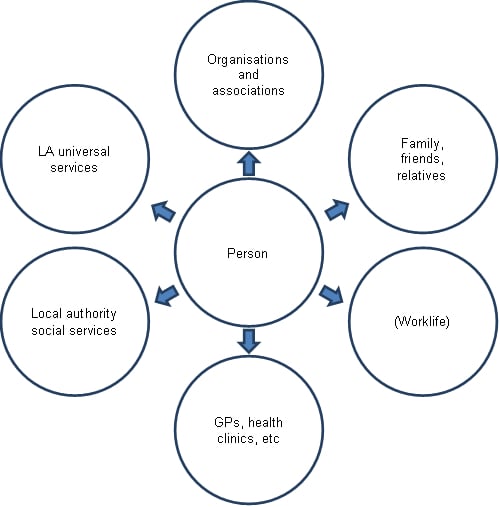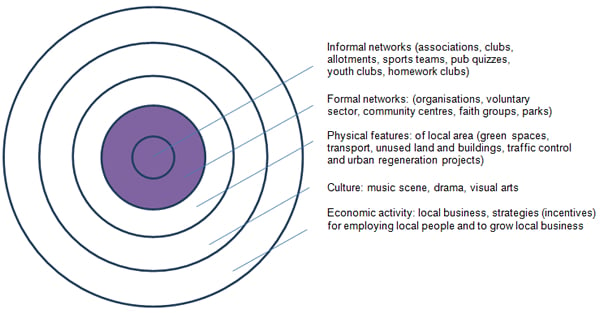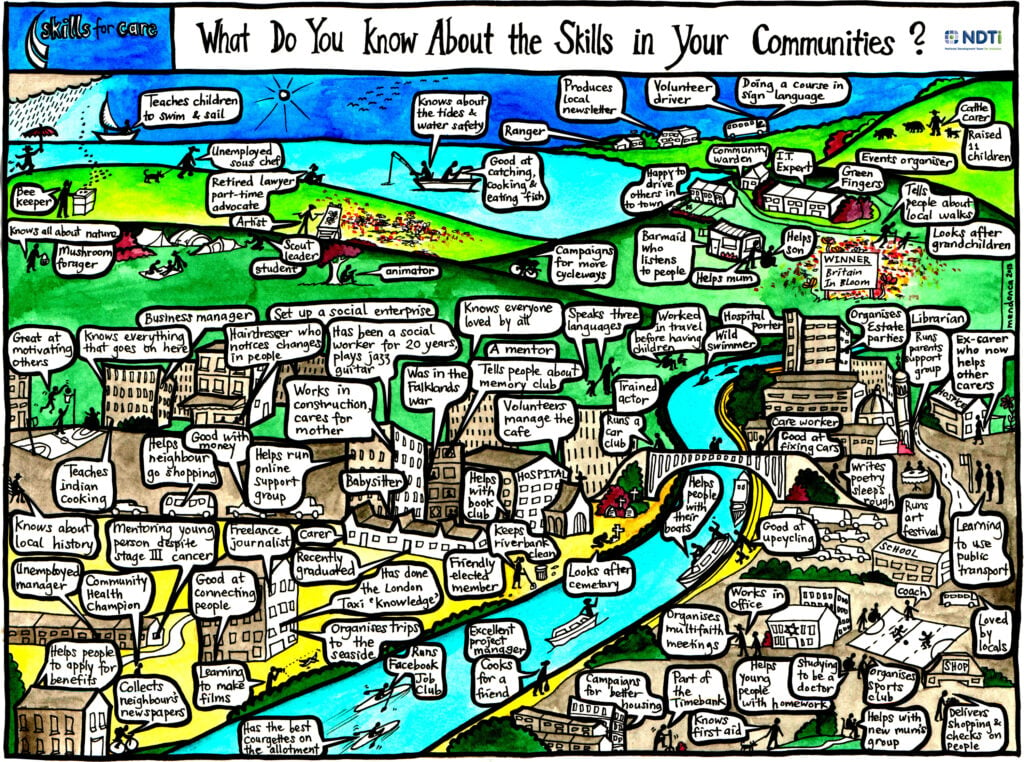
This guide summarises the process and the key elements to consider in relation to using a strengths-based approach. It should be read in conjunction with the Care and Support (Assessment) Regulations 2014 and Chapter 6 of the statutory guidance.
Prevention services based on a strengths-based approach support an individual’s independence, resilience, ability to make choices and wellbeing.
This guide will be updated and links to further good practice will be added when available.
Strengths-based practice is a collaborative process between the person supported by services and those supporting them, allowing them to work together to determine an outcome that draws on the person’s strengths and assets.
As such, it concerns itself principally with the quality of the relationship that develops between those providing and those being supported, as well as the elements that the person seeking support brings to the process. [1]
Working in a collaborative way promotes the opportunity for individuals to be co-producers of services and support rather than solely consumers of those services. [2]
A strengths-based approach to care, support and inclusion says let’s look first at what people can do with their skills and their resources and what can the people around them do in their relationships and their communities. People need to be seen as more than just their care needs – they need to be experts and in charge of their own lives.
Alex Fox, chief executive of the charity Shared LivesThe phrases ‘strengths-based approach’ and ‘asset-based approach’ are often used interchangeably. The term ‘strength’ refers to different elements that help or enable the individual to deal with challenges in life in general and in meeting their needs and achieving their desired outcomes in particular. These elements include:
Practitioners will need to work in collaboration with service users, supporting them to do things for themselves, with the aim that they become more than passive recipients of care and support. In order to do this, it is fundamental that practitioners establish and acknowledge the capacity, skills, knowledge, network and potential of both the individual and the local community.
Preparing for an assessment is key to ensuring the intervention is conducted professionally, that its effects are maximised and that the assessment is both appropriate and proportionate. When preparing for an assessment you should:
The assessment intervention should aim to discover what the person concerned believes would constitute a ‘good life’ for them and their family, and how all parties can work together to achieve this.
In particular the following information should be gathered using open questions rather than a tick-box exercise. The following questions are examples of the type of information that may need to be gathered, although each assessment should be approached on a case-by-case basis, and it may not be necessary or relevant to ask all of the questions suggested here.
Practitioners should ensure that they have fully and accurately understood the individual’s views on the above, and ask for clarification when required. ‘Presenting back’ to the individual is a good technique for confirming the accuracy of information. For example: ‘So what I heard you say is …’; ‘Can I check I’ve understood this as you meant it …’.
It is easy to misunderstand what others say, or to only understand it within our own context. When people talk about things they are very familiar with, they often omit information that could be key to understanding fully and accurately what they mean. Practitioners should ensure as far as possible that no information is missing or misunderstood.
Mrs J, a woman who lives on her own, is introverted and has never had any relationship with her neighbours. However, she says that her relationship with them is ‘good’. For her, this means that they never bother her and she has no interaction with them at all. However, the assessor may understand ‘good’ to mean that the neighbours are helpful and that Mrs J could call on them if she was in need of help.
A focused discussion with the person about their strengths can lead to new opportunities to develop and share skills and make new connections. This is sometimes referred to as a ‘strengths-mapping exercise’. This method of assessment builds a picture of the individual’s strengths and of the community around them. There are two types of strength: ‘soft’ and ‘hard’, each of which applies to the individual and the community.
Individual
Community
Individual
Community
During the assessment it may be helpful to consider the following questions: [3]
It is also important for the practitioner to have an objective understanding of the individual’s views and to ensure that strengths, needs and outcomes have not been over- or underestimated. In order to do this, it may be necessary to speak to others in the individual’s network (ensuring consent is obtained) and/or seek evidence. For example, it may mean observing or establishing via others an individual’s level of mobility. They may have been living with severely reduced mobility over a long period and become accustomed to the considerable limitations this causes them in their day-to-day life, while an objective understanding gained during assessment would help to reveal the true impact on the individual’s wellbeing.
Ms L, 85, is asking for help as she can no longer safely manage her own personal care. During the assessment it emerges that Mrs T, a friend who lives nearby, and who has been providing support until now, including personal care, has suggested that she might not want to continue in future. With Ms L’s permission the assessor talks to Mrs T and discovers that she would in fact be happy to continue if she can be assured that she is doing the right thing and that she would not be expected to do any more if and when the situation changes.
During the discussion it emerges that Mrs T is interested in the option of sharing the provision of support with the local authority. This would allay her concerns about Ms L’s potentially increasing needs, and access to her own support and/or training, along with and further guidance on her caring role, would reassure her that she is ‘doing the right thing’.
It is important in this case for the assessor to explore Ms L’s own view concerning her personal dignity: how does she feel about relying on informal help from someone she knows as opposed to receiving help from a ‘stranger’ from social services? How does she feel about a ‘balance’ of care, as discussed with Mrs T?
The assessor should also ensure that relevant benefits are claimed, such as attendance allowance, which, if appropriate, could be used to pay for informal support. This may in turn help in maintaining Ms L’s dignity by giving her greater control.
At SCIE we asked a group of people using and receiving services, and a group of carers, to share their experiences of being assessed, and tell us what a social worker could do to make an assessment better. Their answers highlighted the following areas.
A local authority can extend the use of the strengths-based approach from assessments to meeting needs. Having identified the person’s strengths and resources in the assessment, the assessor will need to consider how these can be deployed at the care and support planning stage in a sustainable way. It may help to think about how the person currently engages with the community and in what way, by mapping their existing contacts, as shown in the diagram below.

Mapping the person’s existing contacts helps to build an understanding of the people and organisations they already interact with and may trust. A person’s confidence is a necessary prerequisite for adopting a strengths-based approach to meeting needs. In order for this approach to be possible and sustainable, the assessor will need to consider whether the person has the necessary strengths, has the capacity to learn and change their way of doing things, and trusts the networks that they will be relying on. It is vital that the person is empowered and is reasonably determined to make things work.
The strengths-based approach can them proceed via:
These three steps show how the assessor, the commissioner and the care manager need to work together. The assessor needs to identify strengths, harness these to achieve positive change and build support relationships that can make the intervention planned by the commissioner sustainable.
Finding solutions in the community may appear to be a daunting task. For a local authority to reap the benefits of a strengths-based approach, it may help to think of it not as a task, done just for the given individual, but as a strategy that is pursued for the benefit of everyone who approaches the local authority and for the benefit of the wider community. There are a number of ways for assessors, commissioners and care managers to establish community strengths and resources, and two examples follow: local area coordination and community strengths-mapping.
Local area coordination is an approach to assisting local people (including those with care and support needs) to build their personal or family vision and take action for a good life by supporting them to stay strong, safe and connected. With a focus on strengths, aspirations and contributions, the person or family are empowered to build and sustain their networks locally, thus nurturing resilience and independence.
Local area coordinators work in defined communities to support the building of strong local relationships and contribute to sustainable, inclusive and supportive communities. They support individuals to draw on their personal and family resources to solve issues and connect with others who might be able to assist. They also help the person to identify the things they have to offer so that support becomes mutual. This fits into the overall approach of the Care Act to reduce, prevent, and delay the need for intervention.
An example of how a local authority in England has implemented this approach can be seen in Local area co-ordination: supporting transformation in Derby.
Community strengths-mapping is an exercise which can help local authorities conceptualise and describe community strengths. The diagram below sets out how a local authority might think about the community resources that exist around the person. The person’s own contacts in the community may include formal and informal networks (i.e. personal relationships in the form of clubs and/or memberships of organisations). The steps a local authority might take in mapping, negotiating and facilitating access to community strengths might follow this progression:
The diagram below illustrates how commissioners can consider community strengths and resources in terms of what exists around the person being assessed. The purple circles show where people come together outside the local authority’s sphere of direct influence. People’s activity has an impact on other spheres of public life (the white circles), which the council can influence through broader strategic public spending. Assessors can go so far in identifying existing resources, but if a broader strategy to develop local activities is employed, then more spheres can be ‘opened up’, allowing the strengths-based approach to meeting needs to become better resourced and more sustainable.

As the picture below illustrates, our communities are full of people with diverse skills, qualities and life experiences, but this may not always be recognised. Another element of adopting a strengths-based approach is to recognise skills within the community.

Very often it is formal qualifications or professional expertise that are valued, when in fact it is attributes and qualities such as local knowledge, communication skills and a desire to contribute and participate that assist our communities and permit the individuals within them to thrive.
The strengths-based approach starts with the premise that all of us have something to offer, including people who need support to participate fully in the community, and even people nearing the end of their lives.
Having created an overview of the person’s and the community’s resources, the assessor and the commissioner can overlay the person’s needs and skills with those in the community and, in this way, integrate the individual in the wider community. Skills for Care has developed a method for achieving this called ‘Skills around the person’. [3] More information can be found on the Skills for Care website.
The strengths-based approach will in many places result in a cultural shift, with the local authority focusing on the person’s strengths and abilities. It means thinking positively about people who need care and support as well as engaging with the community to reduce isolation and draw those with care and support needs further into community networks. The strengths-based approach is about reducing dependency and challenging ‘prescription culture’. Crucially, it is about protecting and promoting the person’s independence, resilience, choice and wellbeing.
The Care Act requires local authorities to have a strengths-based approach throughout the user’s journey and enshrined within all interventions/interactions with individuals. Here are some of the implications for practice.
The checklist below provides a brief summary of the core duties in relation to conducting a strengths-based assessment. It should be read in conjunction with the Care and Support (Assessment) Regulations 2014 and Chapter 6 of the statutory guidance.
Local authorities must: